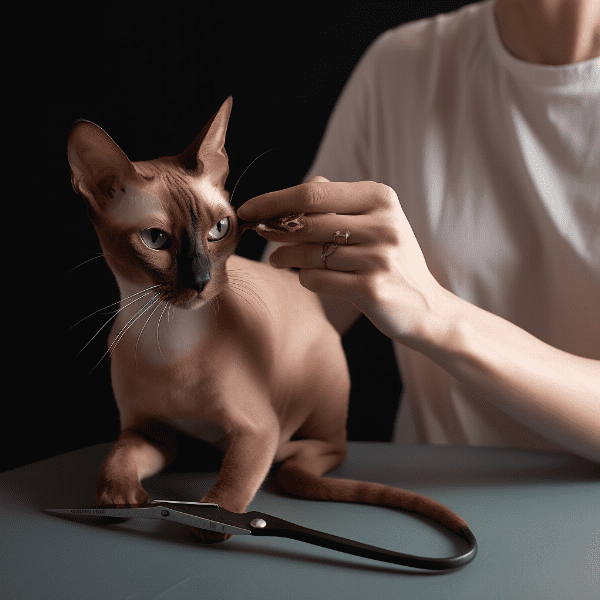Table of Contents
- What Is a Sanitary Shave for Cats?
- Benefits of Keeping Your Cat Clean and Groomed
- Tools and Supplies You’ll Need for a Sanitary Shave
- Step-by-Step Guide to Giving Your Cat a Sanitary Shave
- Tips for Keeping Your Cat Calm and Comfortable During Shaving
- Common Mistakes to Avoid When Sanitary Shaving Your Cat
- Maintaining Your Cat’s Hygiene Between Shaves
- When to Seek Professional Help for Your Cat’s Grooming Needs
- Other Grooming Techniques to Consider for Your Feline Friend
- Conclusion: Why Sanitary Shaving Is an Important Part of Cat Care
What Is a Sanitary Shave for Cats?
A sanitary shave for cats involves trimming the fur around the anus and genital area to help keep your feline friend clean and hygienic. This is particularly important for long-haired cats, as feces and urine can become matted in their fur, leading to discomfort and potential health issues.
Why Is It Necessary?
Keeping your cat’s fur trimmed in the sanitary area is essential for preventing the buildup of feces and urine that can cause infections, odors, and irritation. Additionally, it can help prevent your cat from tracking waste outside of their litter box and spreading bacteria around your home.
How Is It Different from Regular Grooming?
While regular grooming is important for maintaining your cat’s overall health and appearance, a sanitary shave is specifically focused on the area around the anus and genitals. This requires a more precise and careful approach, as these areas are sensitive and require a delicate touch.
When Should You Consider a Sanitary Shave for Your Cat?
It’s generally a good idea to give your cat a sanitary shave every few months to help prevent any hygiene-related issues from developing. However, there are certain signs that may indicate your cat needs a shave sooner, such as excessive matting or soiling of the fur in the area.
Can You Do It Yourself?
Sanitary shaving is a delicate process and should be approached with caution, particularly if you’re not experienced with grooming cats. While it’s possible to do it yourself with the right tools and techniques, it may be safer and more effective to have a professional groomer or veterinarian handle the job.
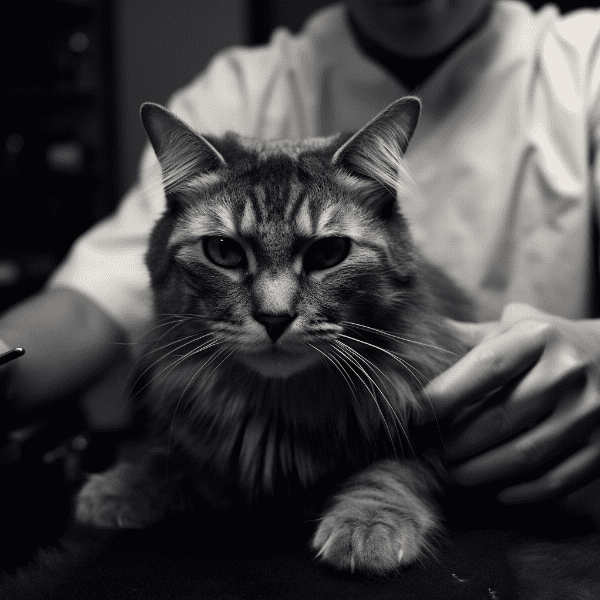
Benefits of Keeping Your Cat Clean and Groomed
Grooming your cat regularly, including providing a sanitary shave when necessary, offers a range of benefits for your pet’s overall health and wellbeing. Here are some of the key advantages:
Preventing Health Issues
Regular grooming, including a sanitary shave when needed, can help prevent a range of health issues. By keeping your cat’s fur clean and free of debris, you can reduce the risk of skin infections, matting, and other issues that can cause discomfort or lead to more serious health problems.
Reducing Hairballs
Hairballs are a common problem for cats, particularly those with longer hair. By regularly grooming your cat and trimming their fur, you can help prevent the buildup of hair in their digestive system, reducing the frequency and severity of hairballs.
Strengthening Bonding
Grooming your cat is an excellent way to strengthen the bond between you and your furry friend. Regular grooming sessions can help build trust and familiarity, and provide an opportunity for you to spend quality time with your pet.
Improving Appearance
Regular grooming, including a sanitary shave when necessary, can help keep your cat looking and smelling great. By removing mats and tangles from their fur and preventing odors and stains in the sanitary area, you can help your cat maintain a healthy, shiny coat.
Reducing Allergens
If you or someone in your household suffers from cat allergies, regular grooming can help reduce the amount of allergens present in your home. By removing loose hair and dander from your cat’s fur, you can minimize the amount of allergens that are released into the air and on surfaces.
In short, regular grooming and sanitary shaving are crucial aspects of cat care that can provide numerous benefits for both you and your feline friend. By keeping your cat clean and comfortable, you can help ensure that they live a healthy, happy life.
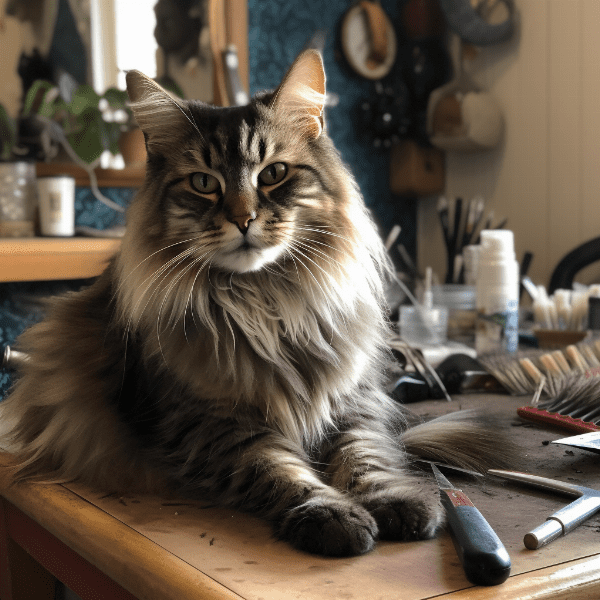
Tools and Supplies You’ll Need for a Sanitary Shave
Before you begin a sanitary shave for your cat, it’s important to gather the necessary tools and supplies. Here are some of the items you’ll need:
Clippers or Scissors
The most important tool you’ll need for a sanitary shave is a pair of clippers or scissors. Clippers are recommended, as they allow for more precise trimming and reduce the risk of accidentally cutting your cat’s skin. However, if you don’t have clippers or aren’t comfortable using them, you can use small scissors instead.
Comb or Brush
A comb or brush is helpful for removing any mats or tangles in your cat’s fur before you begin trimming. This can make the shaving process easier and more comfortable for your cat.
Towels or a Grooming Table
You’ll want to make sure your cat is comfortable and secure during the shaving process. Using towels to create a soft, stable surface or a grooming table can help ensure that your cat stays still and relaxed while you work.
Styptic Powder
Accidents can happen during grooming, so it’s a good idea to have some styptic powder on hand to stop any bleeding in the event of a small cut. This powder can be applied to the affected area to help stop bleeding and promote healing.
Treats and Positive Reinforcement
Finally, it’s important to have plenty of treats and positive reinforcement on hand to help keep your cat calm and relaxed during the grooming process. Offering treats and praise can help your cat associate grooming with positive experiences, making it easier for them to cooperate in the future.
By gathering these tools and supplies before beginning a sanitary shave, you can help ensure that the process goes smoothly and comfortably for both you and your feline friend.
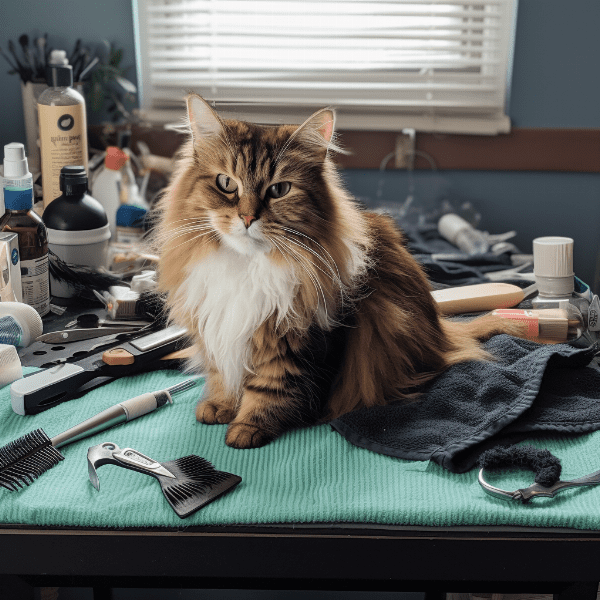
Step-by-Step Guide to Giving Your Cat a Sanitary Shave
Giving your cat a sanitary shave may seem intimidating, but with the right tools and techniques, it can be a simple and safe process. Here’s a step-by-step guide to help you get started:
Step 1: Prepare Your Cat
Before you begin, make sure your cat is relaxed and comfortable. Offer them treats and praise to help them associate grooming with positive experiences. Place them on a soft, stable surface, such as a grooming table or towels on the floor.
Step 2: Trim the Fur
Using clippers or scissors, carefully trim the fur around your cat’s anus and genitals. Be sure to use short, gentle strokes, and avoid pulling or tugging at the fur. Take your time and work slowly, checking frequently to make sure you’re not cutting too close to the skin.
Step 3: Check for Any Remaining Fur
After you’ve trimmed the fur, use a comb or brush to check for any remaining mats or tangles. Gently comb through the fur to ensure that it’s even and free of debris.
Step 4: Clean the Area
Once you’ve finished trimming and combing, use a damp cloth or pet wipes to clean the area. Be gentle and avoid any harsh rubbing or scrubbing, as this can cause irritation.
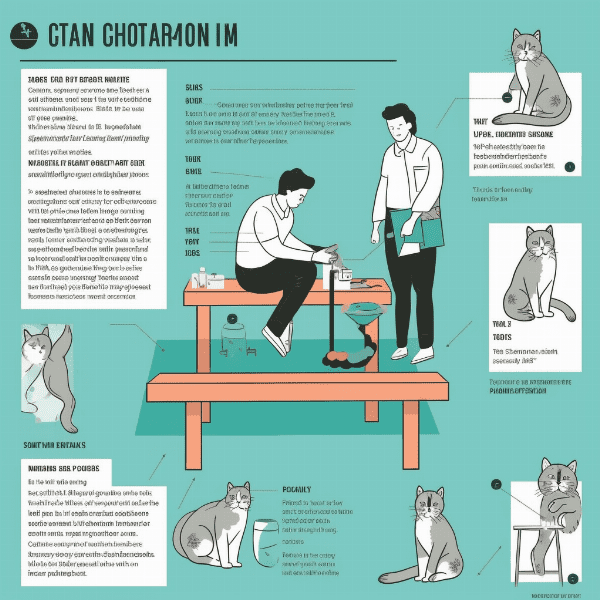
Tips for Keeping Your Cat Calm and Comfortable During Shaving
Grooming, including a sanitary shave, can be stressful for some cats. Here are some tips to help keep your feline friend calm and comfortable during the process:
Start Slowly
It’s important to introduce your cat to grooming slowly and gradually. Start by petting and touching them in the areas where you’ll be trimming the fur, using positive reinforcement like treats and praise to help them associate the experience with positive feelings.
Use Soft Voices and Touches
As you begin the shaving process, use soft voices and gentle touches to help keep your cat calm and relaxed. Talk to them in a soothing tone and offer them treats to help distract them from any discomfort.
Take Breaks
If your cat becomes agitated or distressed during the shaving process, take a break to give them time to calm down. Offer them treats and positive reinforcement, and give them a chance to relax before continuing.
Be Gentle and Patient
When trimming your cat’s fur, be gentle and patient. Use short, careful strokes and avoid any sudden movements that could startle your cat. Take your time and work slowly, checking frequently to ensure that you’re not cutting too close to the skin.
End on a Positive Note
Finally, make sure to end the grooming session on a positive note. Offer your cat plenty of treats and praise, and spend some time playing with them or offering them affection. This can help reinforce positive associations with grooming and make future sessions easier.

Common Mistakes to Avoid When Sanitary Shaving Your Cat
Sanitary shaving can be a delicate process, and there are some common mistakes that you’ll want to avoid to ensure that your cat remains safe and comfortable. Here are a few examples:
Using Dull Clippers
Using dull clippers can make the shaving process more difficult and uncomfortable for your cat. Dull blades can pull on the fur, causing pain and discomfort, and can also increase the risk of accidentally cutting your cat’s skin. Be sure to keep your clippers sharp and well-maintained to ensure a smooth and safe shave.
Cutting Too Close to the Skin
Cutting too close to the skin can be painful and increase the risk of injury or infection. Be sure to use caution when trimming the fur, taking care to work slowly and carefully. Use short, gentle strokes, and avoid pulling or tugging at the fur.
Shaving Too Much or Too Often
Shaving your cat’s fur too much or too often can cause irritation and discomfort, particularly in the sensitive areas around the anus and genitals. Be sure to follow a regular grooming schedule and avoid over-shaving your cat. If you’re unsure about how often to give your cat a sanitary shave, consult with a veterinarian or professional groomer.
Neglecting to Clean the Area
After you’ve finished shaving your cat’s fur, it’s important to clean the area thoroughly to prevent infection and promote healing. Use a damp cloth or pet wipes to gently clean the area, and be sure to avoid any harsh rubbing or scrubbing that could cause irritation.
By avoiding these common mistakes and taking care to approach the shaving process with patience and gentleness, you can help ensure that your cat remains safe and comfortable during grooming. If you’re unsure about any aspect of the process or your cat becomes agitated or distressed, don’t hesitate to seek professional help from a groomer or veterinarian.

Maintaining Your Cat’s Hygiene Between Shaves
While regular sanitary shaves are important for maintaining your cat’s hygiene, there are also steps you can take between shaves to help keep your cat clean and comfortable. Here are some tips:
Clean Your Cat’s Ears
Cleaning your cat’s ears regularly can help prevent ear infections and other issues. Use a damp cloth or pet wipe to gently clean the outer ear, being careful not to insert anything into the ear canal.
Provide Access to a Clean Litter Box
A clean litter box is essential for maintaining your cat’s hygiene. Be sure to scoop the box daily and replace the litter frequently to prevent the buildup of waste and odors.
Monitor Your Cat’s Health
Finally, it’s important to monitor your cat’s health regularly to catch any issues early. Keep an eye out for any changes in behavior, appetite, or energy level, and schedule regular checkups with a veterinarian to ensure that your cat remains healthy and happy.
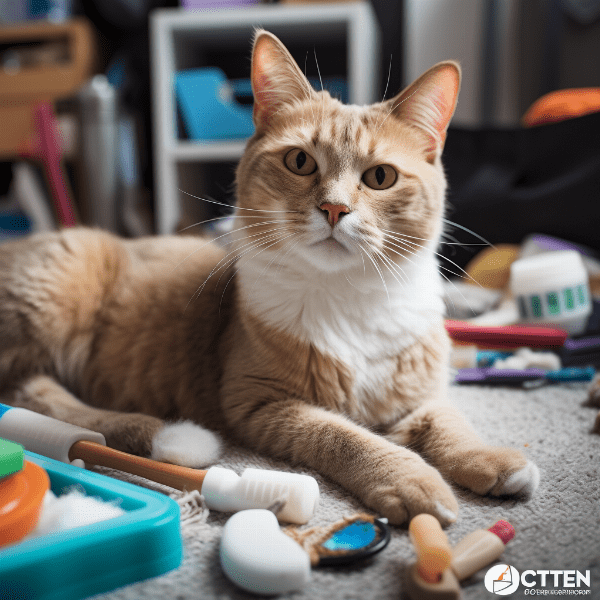
When to Seek Professional Help for Your Cat’s Grooming Needs
While regular grooming and sanitary shaves can help maintain your cat’s hygiene, there may be times when professional help is necessary. Here are some situations in which you may want to seek help from a groomer or veterinarian:
Your Cat Has Matting or Tangles
If your cat’s fur has become severely matted or tangled, it may be difficult to remove the mats without causing discomfort or injury. In these cases, a professional groomer can help safely remove the mats and prevent further issues.
Your Cat Has Skin Irritation or Infection
If your cat has skin irritation or infection in the areas you typically shave during a sanitary shave, it’s important to seek professional help. A veterinarian can diagnose and treat any underlying issues, and may recommend alternative grooming methods to prevent further irritation.
Your Cat Becomes Agitated or Distressed During Grooming
If your cat becomes agitated or distressed during grooming, it may be best to seek help from a professional groomer. They have experience and training in handling cats and can help ensure that the grooming process is as stress-free as possible.
You’re Unsure About How to Groom Your Cat Safely
If you’re unsure about how to properly groom your cat, it may be best to seek professional help to avoid causing discomfort or injury. A professional groomer can show you proper techniques and offer tips for maintaining your cat’s hygiene between shaves.
By seeking professional help when necessary and taking care to maintain your cat’s hygiene regularly, you can help ensure that your feline friend remains healthy, happy, and comfortable.

Other Grooming Techniques to Consider for Your Feline Friend
While a sanitary shave can help maintain your cat’s hygiene, there are other grooming techniques that you may want to consider to keep your feline friend looking and feeling their best. Here are a few examples:
Brushing and Combing
Regular brushing and combing can help remove loose fur, dirt, and debris from your cat’s coat, reducing the risk of matting and tangles. Be sure to use a brush appropriate for your cat’s coat type and brush gently to avoid causing discomfort.
Bathing
While cats are generally able to keep themselves clean through grooming, a bath can be helpful for removing excess oils and dirt from their coat. Use a shampoo specifically designed for cats and avoid getting water or soap in their ears, eyes, or nose.
Nail Trimming
Regular nail trimming can help prevent your cat’s nails from becoming too long and causing discomfort or injury. Be sure to use sharp nail trimmers and avoid cutting too close to the quick, which can cause bleeding and pain.
Teeth Cleaning
Regular teeth cleaning can help prevent dental issues and keep your cat’s breath fresh. Use a toothbrush and toothpaste specifically designed for cats, and avoid using human toothpaste or other substances that could be harmful.
By incorporating these grooming techniques into your cat’s routine, you can help keep your feline friend looking and feeling their best. Be sure to approach each technique with patience and gentleness, and seek professional help if you’re unsure about any aspect of the grooming process.
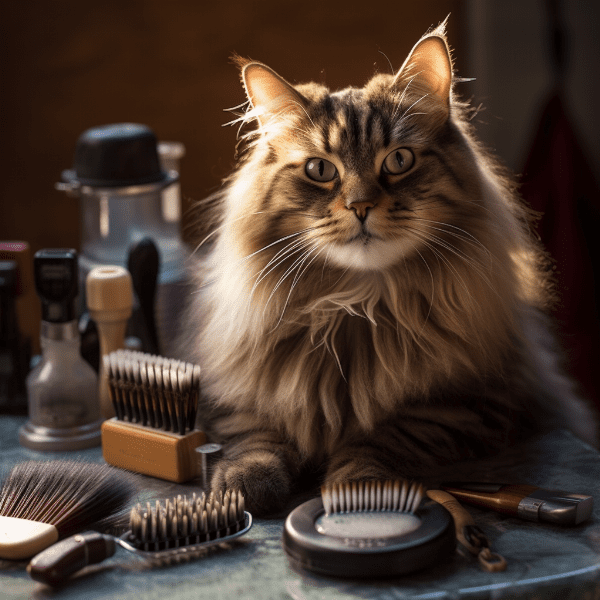
Conclusion: Why Sanitary Shaving Is an Important Part of Cat Care
Regular grooming, including a sanitary shave, is an important part of caring for your feline friend. By keeping your cat’s hygiene in check, you can help prevent issues like matting, tangles, skin irritation, and infection. Sanitary shaving is especially important for the sensitive areas around your cat’s anus and genitals, as excess fur in these areas can lead to hygiene issues and discomfort.
While giving your cat a sanitary shave may seem intimidating at first, it’s a simple and safe process when approached with patience and gentleness. By following the tips and techniques outlined in this guide, you can help ensure that your cat remains clean and comfortable during the grooming process.
In addition to sanitary shaving, there are other grooming techniques to consider for maintaining your cat’s hygiene and appearance, such as brushing and combing, bathing, nail trimming, and teeth cleaning. By incorporating these techniques into your cat’s routine and seeking professional help when necessary, you can help keep your feline friend healthy, happy, and comfortable.
Remember, a well-groomed cat is a happy cat! By taking the time to care for your cat’s hygiene needs, you can help ensure that they live a long, healthy, and comfortable life.



